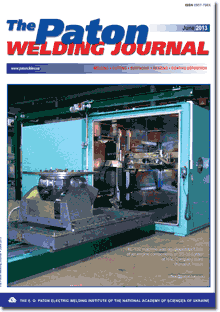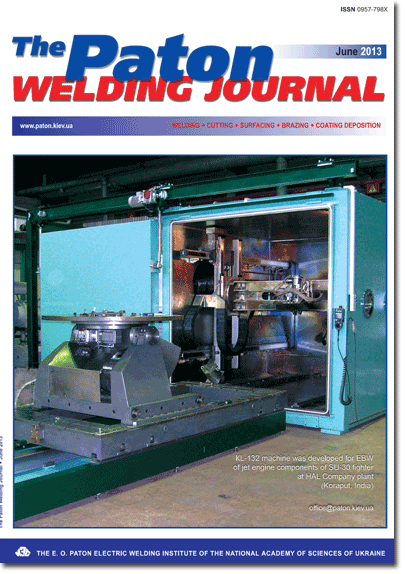| 2013 №06 (02) | 2013 №06 (04) |

The Paton Welding Journal, 2013, #6, 15-22 pages
GASOABRASIVE WEAR RESISTANCE AT ELEVATED TEMPERATURES OF COATINGS PRODUCED BY THERMAL SPRAYING
V.I. POKHMURSKY1, M.M. STUDENT1, A.V. POKHMURSKAYA2, I.A. RYABTSEV3, V.M. GVOZDETSKY1 and T.R. STUPNITSKY1
1H.V. Karpenko Physico-Mechanical Institute, NASU, Lvov, Ukraine. E-mail: pokhmurs@ipm.lviv.ua
2ChemnitzUniversity of Technology, Institute of Composite Materials and Surface Technology, Chemnitz, Germany. E-mail: hanna.pokhmurska@mb.tu-chemnitz.de
3E.O. Paton Electric Welding Institute, NASU, Kiev, Ukraine. E-mail: office@paton.kiev.ua
Abstract
Thermal spraying is becoming ever wider accepted to produce reconditioning and protective coatings for various functional purposes. However, service life of such coatings has not been studied well-enough so far. This work is a study of the mechanism of formation of electric arc sprayed coatings from flux-cored wires of Fe-Cr-B-Al alloying system. It is found that gasoabrasive wear resistance of coatings from flux-cored wires depends on coating hardness, stresses of the first kind in the coating and on composition of oxide films, which form at spraying and at elevated temperatures during gasoabrasive wear testing. Oxide films initially form on the drop surface during spraying. In addition, in air the porous electric arc sprayed coatings are found to have oxidation on the surface and inside the coating (interlamellar oxidation) and oxidation on the boundary between the coating and steel base. It is shown that the high resistance to gasoabrasive wear is observed in coating, in which tensile stresses are transformed into compressive stresses as a result of the process of inner interlamellar oxidation during isothermal soaking at testing temperature of 400-600 °C, leading to increase of coating volume and improvement of its cohesion strength as a result of its reinforcement by interlamellar films of 100-150 nm thickness. Optimum content of alloying elements and their influence on gasoabrasive wear resistance of coatings are determined. Positive influence of residual compressive stresses in the coatings on gasoabrasive wear is shown. Proposed coatings will become applied in power engineering enterprises. 13 Ref., 1 Table, 12 Figures.
Keywords: thermal spraying, coatings, flux-cored wires, gasoabrasive wear
Received: 24.01.13
Published: 28.06.13
References
1. Korobov, Yu.S., Lukanin, V.L., Pryadko, A.S. et al. (2002) Advantage of activated arc metallizing. Svarshchik, 2, 16-17.
2. Borisova, A.L., Mits, I.V., Kajda, T.V. et al. (1991) Structure and properties of electric-arc sprayed ferroboron-based coatings obtained from flux-cored wires. Avtomatich. Svarka, 9, 66-68.
3. Borisov, Yu.S., Korzhik, V.N. (1995) Amorphous thermal spray coatings: Theory and practice. Ibid., 4, 3-12.
4. Borisov, Yu.S., Koziakov, I.A., Korzhik, V.N. (1996) Structure and properties of thermal spray coatings made using flux-cored wires of Fe-Cr-B, Fe-Cr-B-C system. Ibid., 5, 21-24.
5. Pokhmursky, V.I., Student, M.M., Dovgunyk, V.M. et al. (2005) Reconditioning and protective electric-arc sprayed coatings. Lviv: H.V. Karpenka PhMI.
6. Pokhmurska, H., Wielage, B., Grund, T. et al. (2008) Arc-sprayed coatings obtained from iron based cored wires under high-temperature abrasive wear conditions. In: Proc. of Int. Thermal Spray Conf., 338-341.
7. Student, M.M., Pokhmurska, H.V., Hvozdetskyi, V.V. et al. (2009) Effect of high-temperature corrosion on the gas-abrasive resistance of electric-arc coatings. Materials Sci., 45(4), 481-489.
8. Dallaire, C.S., Levert, H., Legoux, J.-G. (2001) Erosion resistance of arc-sprayed coatings to iron ore at 25 and 315 °C. J. Thermal Spray Techn., 10, 337-350.
9. Branagan, D.J., Swank, W.D., Haggard, D.C. et al. (2001) Wear resistant amorphous and nanocomposite steel coatings. Met. and Mater. Trans. A, 32(10), 2615-2621.
10. Branagan, D.J., Alman, D.E., Newrick, J.W. (2001) Devitrified nanocomposite steel powder. In: Powder metallurgy alloys and particulate materials for industrial application. Warrendale, PA: Minerals, Metals and Mater. Soc., 111-122.
11. Branagan, D.J., Tang, Y. (2002) Developing extreme hardness (>15 GPa) in iron-based nanocomposites. Composites, 6, 855-859.
12. Badish, E., Katsich, C., Winkelmann, H. et al. (2010) Wear behaviour of hardfaced Fe-Cr-C alloy and austenitic steel under 2-body and 3-body conditions at elevated temperature. Tribology Int., 2, 214-228.
13. Babichev, M.A. (1955) Methods for determination of internal stresses in machine parts. Moscow: AN SSSR.
Suggested Citation
V.I. POKHMURSKY1, M.M. STUDENT1, A.V. POKHMURSKAYA2, I.A. RYABTSEV3, V.M. GVOZDETSKY1 and T.R. STUPNITSKY1 (2013) GASOABRASIVE WEAR RESISTANCE AT ELEVATED TEMPERATURES OF COATINGS PRODUCED BY THERMAL SPRAYING. The Paton Welding J., 06, 15-22.The cost of subscription/purchase order journals or individual articles
| Journal/Currency | Annual Set | 1 issue printed |
1 issue |
one article |
| TPWJ/USD | 384 $ | 32 $ | 26 $ | 13 $ |
| TPWJ/EUR | 348 € | 29 € | 24 € | 12 € |
| TPWJ/UAH | 7200 UAH | 600 UAH | 600 UAH | 280 UAH |
| AS/UAH | 1800 UAH | 300 UAH | 300 UAH | 150 UAH |
| AS/USD | 192 $ | 32 $ | 26 $ | 13 $ |
| AS/EUR | 180 € | 30 € | 25 € | 12 € |
| SEM/UAH | 1200 UAH | 300 UAH | 300 UAH | 150 UAH |
| SEM/USD | 128 $ | 32 $ | 26 $ | 13 $ |
| SEM/EUR | 120 € | 30 € | 25 € | 12 € |
| TDNK/UAH | 1200 UAH | 300 UAH | 300 UAH | 150 UAH |
| TDNK/USD | 128 $ | 32 $ | 26 $ | 13 $ |
| TDNK/EUR | 120 € | 30 € | 25 € | 15 € |
AS = «Automatic Welding» - 6 issues per year;
TPWJ = «PATON WELDING JOURNAL» - 12 issues per year;
SEM = «Electrometallurgy Today» - 4 issues per year;
TDNK = «Technical Diagnostics and Non-Destructive Testing» - 4 issues per year.


